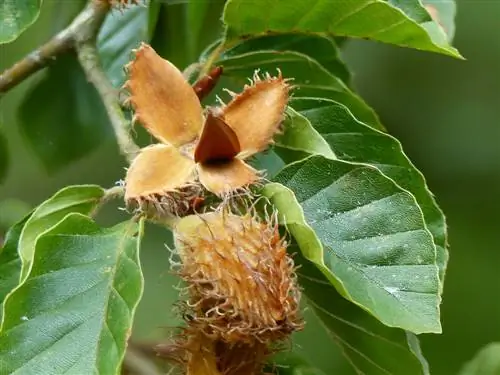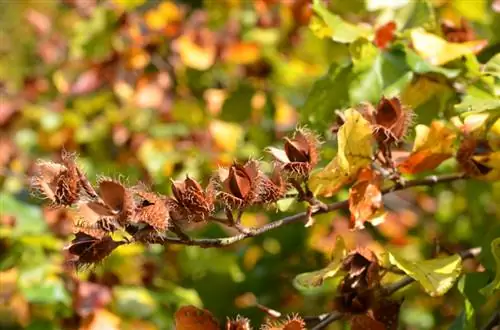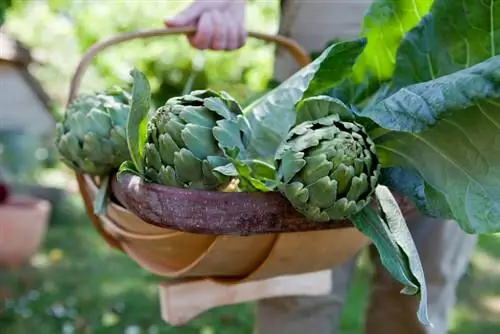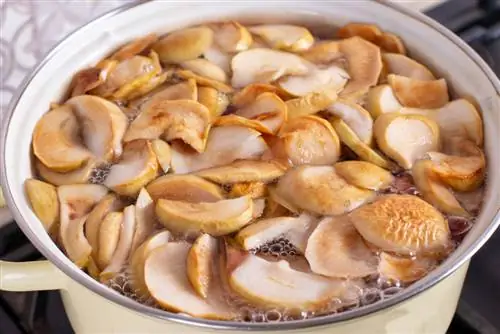- Author admin [email protected].
- Public 2024-01-05 20:48.
- Last modified 2025-06-01 06:02.
If you know beechnuts and know how to use them, you're in a good place. Because the nutritious and tasty forest fruits are a great addition to a natural and self-sufficient menu. You can read about the nutrients it contains, possible uses and possible risks in this article.
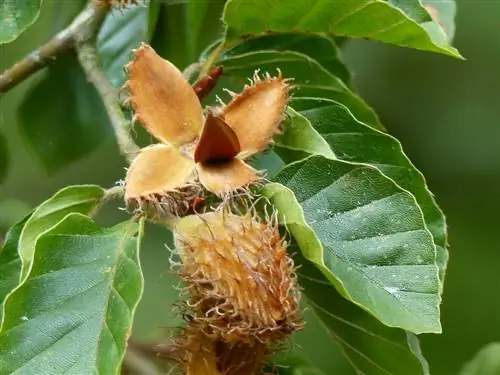
Botanical portrait of beechnuts
Beechnuts are the nuts of beech trees (botanically Fagus), more precisely of common beech trees. The common beech is the only common beech species in Germany, so that in folk etymology the name beech tree is only reserved for its fruits. Other types of beech, such as the Crimean beech or the American beech, produce similar nuts that can also be used in a similar way. In this article we want to concentrate on the fruits of our native beech, i.e. the real beechnuts.
Excursus
Hornbeams are not beeches
Hornbeams are only related to common beeches by name, not botanically. They do not belong to the genus Fagus, but to the genus Carpinus and are part of the birch family instead of the beech family. Only at the taxonomic level of the order do the threads of common beech and hornbeam come together, because both belong to the beech family (Fagales). Nevertheless, the hornbeam really looks like a smaller European beech and that is why it gets its name. It even produces similar nuts that are also edible.
Beechnuts - the fruits of copper beeches
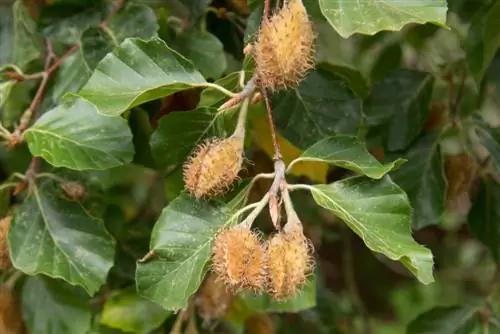
Beechnuts are the fruits of the common beech tree
The common beech, botanically Fagus sylvatica, is one of the most widespread deciduous trees in Central Europe. Not only does it occur naturally in large populations in local deciduous and mixed forests, it has also been used by humans for a long time. It is not only their very hard, solid and homogeneous wood that is valued, which is ideal for building purposes and as fuel. Their fruits also played a more important role as a source of food for people and their pets for a long time.
The fruiting phase of copper beeches
Common beeches only start producing fruit when they are around 40 years old and stop again when they are around 80 years old. In view of the entire lifespan, which for a common beech can extend to around 300 years or more, this is a relatively short fruiting phase.
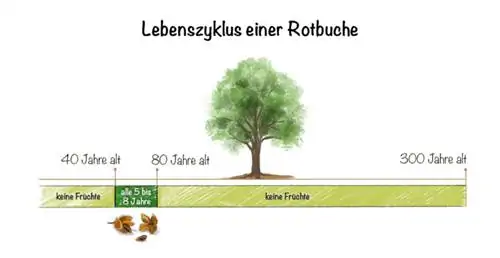
The fruiting phase itself, like many other trees, is characterized by a cyclical cycle. This means that there are years with a lot of fruit at fairly regular intervals. With beech trees, such rich fruit production occurs every 5 to 8 years. In forestry language one speaks of a fattening year, a term from earlier times when domestic pigs were driven into the forest for fattening with beechnuts and acorns.
Apart from the basic cyclical rhythm, the abundance of fruit also depends on the climatic conditions in the individual years. After a very hot year, a beech tree likes to form a lot of corners, unless it has just had a mast year and is exhausted for the time being.
Excursus
The Amazing Mast Year Strategy
The periodic overproduction of fruit in beeches and other fruit-producing trees is a fascinating survival strategy. In order to be able to reproduce effectively through the fruits, some of them must always have the chance to settle in the soil. And with the large, hungry number of candidates for the nutritious beechnuts in the forest, this is not so easy to guarantee. In order to ensure that there are enough fruits left over, the common beech has resorted to making the great effort of overproducing fruit in individual years and recovering from it between the mast years.
Appearance and ecology of beechnuts
Before we turn to the diverse culinary uses of beechnuts, let's first look at their external appearance - because that is definitely worth a little appreciation. With their fine, distinctly triangular, pointed shape and their shiny red-brown color, the beechnuts not only have an unmistakable character, but also a charming and very pretty character.
The egg-shaped beechnuts are about 1.5 centimeters long and are usually surrounded in pairs by a 3 to 7 centimeter long fruit cup. When the fruit ripens in September, its 4 soft-spined lobes spread open and the two nuts appear.
Let's take another look at the identifying features of beechnuts in their different stages:
| Beechnuts on the tree | Beechnuts on the ground | Seed under the shell | |
|---|---|---|---|
| Size | In the fruit cup 3-7 cm long | without fruit cup approx. 1.5 cm long | approx. 1 cm long |
| Appearance | closed fruit cup usually still greenish, soft prickly, brown when cracked | Corners usually detached from fruit cups, shiny reddish-brown, elongated-ovoid, pointed at the front, square, indented in between | greenish before fruit ripening, white when germinating |
Pulling beeches from beechnuts
Of course, beechnuts are primarily there for the propagation of the common beech. If you want to grow your own beech tree, you can do so using beechnuts. But it's not that easy. It takes a lot of care and patience until a fully grown tree is created. You can be all the prouder when it's successful and the specially grown European beech tree is in the garden. The sowing process can be divided into the following steps:
1. Collect seeds in early autumn
2. Sort fruits according to germination
3. Preparing (stratifying) seeds4. Sowing
Collecting seeds
You can either collect seeds yourself in a beech forest from September onwards or buy them from a seed farm. Collect seeds and prepare beechnuts on a large scale.

Of course, the beech breeding project is only completely self-sufficient if you not only sow the seeds yourself, but also collect and prepare them yourself. If possible, collect fruits that are still hanging on the tree and in fruit cups that are still closed, as well as fruits with cracked fruit cups from the ground. This means you have a higher chance of having many germinable ones.
An indication that the seeds in the shells are capable of germinating is if the seeds turn white. Because you should not open the corners you have chosen to take with you when collecting them, you can randomly test the whiteness and thus the germination of other corners of the mother tree.
Sorting seeds
At home, put the beechnuts in water to sort out the empty fruit casings. You can recognize them because they swim upwards. The pericarp, which contains seeds, must then be stratified for germination.
Stratify seeds
In seed cultivation, stratification refers to the imitation of natural seed dormancy after falling from the mother plant. So that the seed does not sprout in harsh winter conditions, it falls into a kind of hibernation. As a seed farmer, you imitate this by storing it in a cool place, protected from light, temperature fluctuations and microorganisms. The best way to stratify beechnuts is to store them in the garden soil and cover them with beech leaves, loose soil and perhaps a few spruce needles. Soil similar to that of the mother plant is ideal for seed dormancy and subsequent germination.
But it is important that you protect the beechnuts from squirrels and mice, who would hardly disdain such a find during the waking phases of their hibernation. To do this, you can fence and cover the area with close-meshed rabbit wire.
Sowing
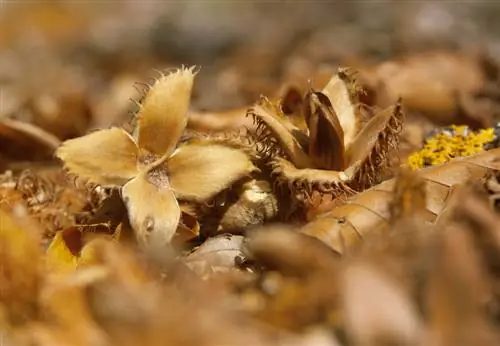
Beechnuts need frost to germinate
If you have already conveniently stored the seeds directly at the desired sowing site for stratification, you actually only need to wait for spring when the temperatures are warmer. When it gets reliably warmer, provide regular water if possible to encourage the seedlings to emerge. If they appear, you should definitely maintain and, if necessary, reinforce the protection with rabbit wire. Especially if red or wild deer in your area like to get lost in gardens and appreciate young trees as spring food.
In order to get a common beech tree into the garden, you can also look for self-produced seedlings in forests with common beech stocks in spring, dig them up and transplant them into the garden. But here, too, you have a better chance of the tree growing well if you take some soil from the forest with you for transplanting and protect the young tree from predators by fencing it off.
Culinary uses of beechnuts
Beechnuts are highly valued by forest dwellers. Wild boars, squirrels, birds and mice use them to build up a secure supply of energy before winter and store them for their interim reinforcement during hibernation.
What animals do intuitively has of course long been backed up by us humans with facts. From a nutritional perspective, beechnuts are indeed extremely energy-giving nutrient suppliers:
- Lipid content of over 40% (fatty acids)
- Vitamins (B vitamins)
- many valuable minerals (e.g. sodium, potassium, sulfur)
- rich in trace elements (e.g. zinc, iron)
- Amino acids
With this composition, beechnuts are real energy donors. It is not for nothing that they have always been a popular collection item for people in times of need. During and after the great wars, people collected them to make flour or use them roasted as a substitute for coffee. At times, oil was even extracted from the lipid-containing beechnuts.
Today, in a time of food abundance, beechnuts only play a role as food for those interested in nature and self-sufficiency. As a result of the trend towards regionality, seasonality, natural nutrition and anti-consumerism, beechnuts are deservingly likely to receive noticeably more attention again.
Things to consider when eating beechnuts

Beechnuts should only be eaten raw in moderation
Beechnuts are nutritious and really tasty with their nutty aroma. However, you should not consume large quantities of them raw. Because they contain trimehtylamine, which is also called fagin according to the beech's genus name 'Fagus', alkaloids and a lot of oxalic acid. This makes beechnuts slightly poisonous when raw.
However, the symptoms of poisoning only occur in sensitive people and only when large quantities are consumed and are limited to abdominal pain, nausea, vomiting and diarrhea. In extreme cases, symptoms of paralysis and cramps are said to have occurred. If you are he althy and not overly sensitive, you can taste a few beechnuts while walking in the forest. When heated by cooking or roasting, the toxic substances are broken down, so that there should be no risk of poisoning if larger quantities are consumed, even for more sensitive people.
Toxicity to pets
However, you should exercise careful caution when it comes to pets. In certain species, the toxicity of beechnuts can have fatal consequences. Horses, calves and guinea pigs in particular are susceptible to the toxins and can react with breathing difficulties, tremors, dilated pupils, vomiting, diarrhea and symptoms of paralysis. For horses, an amount of 300-1000 g is considered potentially fatal.
Dogs are mentioned less in the relevant literature on the toxicity of beechnuts, but they should not eat large quantities either. If you have very curious and carefree four-legged friends, you should be careful when walking in beech forests.
Delicacies made from beechnuts
If you know what to look out for, you can enrich your diet with beechnuts very profitably. Beechnuts are particularly recommended for the following treats:
- Bread
- Cake
- Cookies
- Coffee substitute
- Pesto
- Salad and spread garnish
Baking with beechnut flour
The recycling method that was widespread for a long time was grinding into a type of flour. Of course you can still do that today. Before grinding, for example in a grain mill, you should heat the fruit in some way. On the one hand, to break down the toxins and make them more digestible, but also, on the other hand, to be able to process them better and improve their taste.
On the one hand, you can scald the nuts with boiling water. This ensures the initial breakdown of toxins and bitter substances and also makes it a little easier to remove them from the peel. Above all, any empty shells can be separated from the full ones, because the empty ones float to the surface of the water and can be skimmed off from there. Roasting in a coated pan without fat (the fruits themselves contain enough of it) or baking in the oven is even better for breaking down toxins and making peeling easier. It also creates a pleasant roasted aroma.
After peeling, the corners can be roasted again if necessary. This increases the digestibility and the roasted aroma. Furthermore, some of the fine skins come off and with them more bitter substances. The peeling of the skins is also a sign that the nuts are finished roasting. If possible, wait for the moment when the nuts already give off a pleasantly roasted aroma but have not yet burned. Then you can let them cool and then grind them in a grain mill, with a simple hand coffee grinder or a mortar.
Breads and cakes made from beechnut flour can be prepared savory or sweet and can be enriched with, for example, blackberries, dates and pears, spicy herbs such as black clover and fennel seeds or with kefir.
Mix beechnut flour if necessary
In general, beechnut flour is only suitable as an addition to grain flour. Pastries made from beechnut flour alone taste good and are significantly less bitter than pastries made from acorn flour. Because of the lack of gluten, the results don't hold together well. If you want to enjoy the original, spicy taste of beechnut flour, you can also use binding agents such as eggs.
Coffee made from beechnut flour
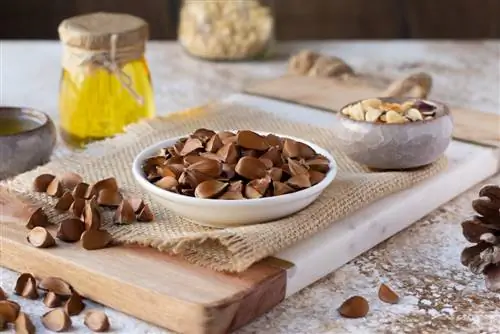
You can make a lot of things from beechnuts
You shouldn't necessarily brew a coffee substitute from pure beechnut flour. Similar to coffee made from roasted and ground acorns, it simply tastes too bitter. In order to achieve a pleasantly tasty result, it is better to mix in grain coffee and/or slightly sweetening spices such as cinnamon or cocoa.
Pesto with beechnuts
Beechnuts can also be used wonderfully for pestos. But here too, they should only be used as a supplement. Chopped and roasted, they can form the oily base together with pine, walnut or cashew nuts. For the fresh, green seasoning, wild garlic or other flavor-intensive wild herbs such as gourd, garlic mustard or meadow sage are naturally suitable.
Salad and spread garnish
Chopped and roasted beechnuts are also highly recommended as a garnish for autumn salads with lamb's lettuce and grated carrots or as a crunchy addition to a hearty spread made from quark, tomato paste, pumpkin and turmeric.
Frequently asked questions
Which tree do beechnuts belong to?
Since the name Buchecker comes from German (Ecker from ahd. ekarn and mhd. ackeran, ecker(n)), it also refers to the only beech species that occurs naturally in Germany. This is the common beech, botanically Fagus sylvatica. Other beech species such as the Crimean beech or the American beech bear similar fruits with similar properties, but are not actually referred to with the original German word beechnuts because of their non-German distribution areas.
How do I recognize beechnuts?
Beechnuts have a characteristic appearance: their approximately 1.5 cm long, egg-shaped, pointed shape, their three sharp longitudinal edges with indentations in between and their red-brown color are unmistakable. On the outside they are covered by a soft, spiny fruit cup, the four lobes of which spread apart when the fruit ripens. They are usually found under the beeches on the forest floor. Some of them come loose on their own, so they have to be picked up loosely.
Can you eat beechnuts?
Beechnuts are edible and have always played a role in people's diet, especially in times of emergency and war. They can be used, for example, as flour and meal for bread, cakes or as a coffee substitute, as well as made into puree in pestos or roasted whole as a crispy garnish for salads. Because of their slight toxicity, beechnuts should not be consumed raw in large quantities. Heating in the form of cooking, roasting or baking removes the toxins (trimethylamine, alkaloids and oxalic acid)
Are beech nuts poisonous?
Beechnuts are slightly poisonous and can cause mild symptoms of poisoning if consumed raw in excess, especially in sensitive people. These include rejection reactions of the digestive tract such as abdominal pain, vomiting and nausea, and in rare cases also paralysis and cramps. The toxins contained, especially trimethylamine, alkaloids and oxalic acid, can be broken down by heating. When it comes to domestic animals, it is primarily horses and calves for whom beechnuts can be poisonous and even fatal. Guinea pigs and dogs should also not eat the fruit.
Can you also buy beechnuts and beechnut products?
If you are interested in using beechnuts out of season or want to plant a common beech tree, you can also buy beechnuts with patient research. They are primarily marketed as seeds, so you can find them in seeds. You can also buy the tasty and he althy beechnut oil from selected oil mills. Specialized retailers for natural craft materials or florists sometimes also offer hand-picked beechnuts or their empty fruit cups for decorative purposes.

